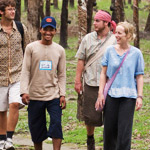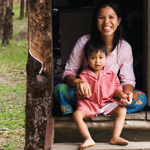Andaman Discoveries Blog
Monday, August 22, 2011
Teaching the Teachers?
Southern Thai Cooking

 After eating delicious food at one of our classes recently, the volunteers had the option to visit the nearby waterfall and swim in the clear cool waters. They also got a chance to visit our beautiful local beach were they relaxed, took pictures and swam in the sea watching the sunset over the clear horizon.
After eating delicious food at one of our classes recently, the volunteers had the option to visit the nearby waterfall and swim in the clear cool waters. They also got a chance to visit our beautiful local beach were they relaxed, took pictures and swam in the sea watching the sunset over the clear horizon.
Labels: Thai food, volunteering Thailand
Monday, August 16, 2010
Famous Thai Food
Delicious Thai Cooking Class
KanoomJeen Saonam - Rice Noodle with Coconut Milk and Pineapple
Ingredients:
1 kg rice noodle
1 head pineapple
¼ cup ground dried shrimps
½ cup thin slice ginger
7 small head garlic
¼ cup of chili
Soy sauce, lime , sugar
Directions:
1.Peel the pineapple and remove eyes. Coarsely chop the pineapple
2.Peel the garlic and thin slice widthwise remove to the plate
3.Peel the ginger and thin slice lengthwise remove to the plate
4.Thin slice the chili and remove into the plate
5.Ground dried shrimp and remove into the bowl
6.Mixed soy sauce, lime and sugar in a bowl add some chili and garlic
7.Heat the coconut milk in a small pot, add some salt and stir for 5 minutes remove from the heat and let it cool
8.Served rice noodle with pineapple chopped, garlic, ginger, chili, ground dried shrimp, sauces and on top coconut milk.
Labels: staff development, Thai culture, Thai food
Saturday, August 1, 2009
Leslie’s Top 10 Thailand Highlights
There are far more than 10 things I’d like to rave about, but in the Twitter age, I think this will do the trick. In no particular order, here is my Top 10 list from this February to July that I spent with AD.
Thank you to the AD team, the town of Kuraburi, and all the many other wonderful people who made me feel at home in Thailand.
Cheers,
Leslie
1. Jai Yen + Sanuk + Mai Pen Rai = Awesome
Three phrases I wish I could have brought home to the U.S. from the Thai culture include jai yen (cool heart), sanuk (having fun) and mai pen rai (it's not important). The phrases are a large part of the core that is the Thai way of life.
2. Andaman Discoveries
The AD team is one of the hardest-working groups of people I’ve met. They believe in what they’re working for and it’s like a small family. If you come to Thailand to work with AD, you might not want to go home. There has been a trend with the team where people plan to come for short periods but extend their commitment. For example, Karen Spackman originally came for three months. However, she fell in love with life in Kuraburi and has just renewed her visa for a second year.

3. Diversity
There are 76 provinces, 148 national parks, and an estimated population of 64 million people spanning a country that is 514,000 square kilometers. About 10 million Thailand residents call Bangkok and its surrounding area home.
Being bored in Thailand may be the least of anyone’s worries. The country is separated into four distinct natural regions. Each offers a diverse landscape to explore. Just Thailand’s national parks alone could keep someone entertained for years.
Statistics are from the United Nations Thailand, Tourism Authority of Thailand, and Thailand’s Department of National Parks, Wildlife and Plant Conservation.

4. The Markets
Every town I visited in Thailand had a market worth visiting. There is a morning and night market in Kuraburi with friendly vendors dishing up rice soup, barbecued meats, fish, waffles, roti, pad Thai and fresh produce. Wandering the markets in search a snack or meal is a great way to try new foods and practice language skills.

5. Kuraburi Restaurants
The best food I had in Thailand was in Kuraburi. Cucina Andaburi was an AD team favorite. The food was exceptional, but it was made better by the personable chef, Tu, who often doubles as an AD guide on village tours.

6. Warm Sea Water
Swimming in Lake Washington near my home city of Seattle, even with a wetsuit, can be a grimace-filled experience at times. Playing in the Andaman Sea felt more like a trip to a spa.
7. Dance Aerobics
Dance aerobics seemed to be wildly popular in Thailand. I heard energetic music while wandering Lumpini Park in Bangkok. The source of the fast beats was a nightly aerobics class with about 100 people jumping, dancing and working up a sweat to imitate the movements of a lively instructor. There are week-night community aerobics in Kuraburi too. It’s worth going just for the fun music and contagious energy.

8. Saying Goodbye to Skin Cream
Some people acclimate to new climates. I was not one of them. I sweated as much on my last day in Thailand as I did on the first. The good news was that I got to say farewell to a routine of lathering up in skin lotion to avoid looking like a lizard. The only change in my body happened in my brain, as I grew to love the heat and humidity.
9. Koh Ra Ecolodge
A 20-minute boat ride from Kuraburi Pier takes people to a seemingly-secluded island called Koh Ra. The ecolodge is a fun vacation spot in itself. However, the dedication and kindness of the staff is the reason I put the ecolodge in my top 10. Kim, Awe and Joom are three smiling people who helped make my Thailand experience. Read about my visit to the ecolodge here.

10. Fruit Galore
The fresh fruit readily available in Thailand makes me think of the scene in the movie, Forest Gump, when Bubba lists all the types of shrimp. Bubba says, “Anyway, like I was sayin', shrimp is the fruit of the sea. You can barbecue it, boil it, broil it, bake it, sauté it. Dey's uh, shrimp-kabobs, shrimp creole, shrimp gumbo. Pan fried, deep fried, stir-fried. There's pineapple shrimp, lemon shrimp, coconut shrimp, pepper shrimp, shrimp soup, shrimp stew, shrimp salad, shrimp and potatoes, shrimp burger, shrimp sandwich. That- that's about it.”
It was rare to go a restaurant in Thailand and not have the beverage option of fruit shakes with a selection of watermelon, mango, pineapple, papaya, banana and many more to choose from.
What was my favorite fruit in Thailand? The Queen of Fruit, of course, also called the mangosteen and mankut. Read about mangosteen here.

Labels: Koh Ra Ecolodge, Kuraburi, staff, Thai food
Saturday, June 27, 2009
Rebecca's Journal - First Day in Thailand
My journey to Thailand was less than successful: sleep was merely a dream, the flight was exorbitantly long and then came the ill-fated misplaced luggage. I quickly began to wonder if leaving England for Thailand was such a bright idea after all.
As I made the trip from Phuket to Kuraburi, I felt a smorgasbord of emotions. Nervousness and curiosity consumed me as I was unsure of what lay ahead.
I arrived at the Andaman office tired and dazed. Kelly, Karen and Leslie greeted me, offering a warm welcome. I felt at ease and my nerves subsided immediately.
 |
| Kelly May describes the different Thai dishes to Rebecca at a team dinner. |
They took me to see the house that would be home for the next month. My first reaction was a tinge of shock. Thai houses are different from those in England. For starters, it came with geckos, but more on that later. I loved that my house was pink, but was unsure how enjoyable cold showers would be.
Once I was settled into the pink house, the team invited me to experience my first lunch in Thailand. We traveled to a restaurant about five minutes from Kuraburi for the traditional Thai meal, Som Tam, a salad made from un-ripened papaya. I was impressed even though the meal had more spice than my England taste buds were used to.
I couldn’t have been happier to go to bed at the close of the first day in Thailand. My initial feelings of nervousness were replaced with excitement for the next day ahead.
Labels: Kuraburi, Thai food, volunteer
Wednesday, June 3, 2009
Fruits of Thailand – Meet the Queen
 Experiences in Thailand
Experiences in ThailandBy Leslie Welshimer
If someone had said the word, “fruit,” to me five months ago, my brain would have conjured up images of apples, oranges and bananas. If I were feeling really posh, I may have conjured up thoughts of fruits like blueberries and raspberries.
My fruit world has been shaken up in Thailand. The fruit in Thailand is easily in my top 10 favorite things here. It’s like fruit paradise, where mangos, fresh coconuts, pineapples and papayas fall from the sky.
The markets are full of tables of seemingly every fruit imaginable. Many of the fruits have exceeded my imagination, as I didn’t even know they existed before.
I could easily write a book just about the fruits here, but since I know everyone is busy, I’ll start by focusing on one of the most highly regarded and talked about fruits for this blog entry – Meet the Queen of Fruit.
The mangosteen (called mankut) is commonly referred to as the “Queen of Fruit”. It arrives on the scene in May and typically thrives until September.
Many meals I’ve had in southern Thailand have concluded with mangosteen for dessert. In my impression, the mangosteen is a bit like a marriage of a pineapple and orange. It’s a happy marriage indeed.
Its skin is thick with dark-red/ purple color. To uncover its sweet inside, you push in with your fingers, twisting slightly to loosen its grip and then the skin is peeled with ease. When ripe, the mangosteen should open with gentle finger pressure.
Inside, you’ll discover soft, white segments that resemble the appearance of the interior of a tangerine. The taste is sweet, with a slight tangy flavor.
You can eat mangosteen guilt-free. It is said to be nutritious and contains healthy benefits like calcium, phosphorus, vitamin B and C.
 Mangosteen, like many other fruits, also makes a "mean" juice and smoothie that is as delicious as the fruit in its original form.
Mangosteen, like many other fruits, also makes a "mean" juice and smoothie that is as delicious as the fruit in its original form.If you are lucky enough to visit southern Thailand during mangosteen season, be sure to wander the local markets to treat your senses to the Queen of Fruit.
Do you have a favorite fruit common in Thailand or a memorable Thai food experience? Don’t be shy – share your thoughts.
Andaman Discoveries welcomes blog and newsletter comments. Also, the team enjoys sharing personal insights. Contact us with your first-hand stories.
Labels: mangosteen, Thai food
Tuesday, March 17, 2009
Gin Khao Reu Yang?
 Experiences in Thailand
Experiences in ThailandBy Leslie Welshimer
It began with an intense craving for American food – a meal of a tuna sandwich, fries and a salad.
As I was savoring my meal, another farang smirked and laughed as he walked by my table, mocking my choice of dinner. And, so it began. March 6 marked the beginning of a one-month pact to eat only local cuisine in Kuraburi.
Prior to living in Thailand, I too mocked the thought of travelers dining on Western food abroad. Then by week three in Thailand, it occurred to me that I had been a giant, judgmental hypocrite for mocking others.
| Week one of Western-food free month included a visit to Tung Dap village where we feasted on crab, squid and fresh coconut for a beverage. |
It had never occurred to me that the ability to get nearly any type of food, at any time, is a luxury. Yes, I realized, I had taken that delicious, juicy burrito, the size of a baby, for granted. Gorditos, please forgive me.
Other than a Gorditos-absent environment, what is different about eating in Thailand? For starters, Thai food is generally eaten with a fork and a spoon. The spoon is the star of the show, bringing the food to your mouth. The fork, held in the left hand, is used like a knife in Western cultures to push food into the spoon. Chopsticks are used rarely, primarily for the consumption of noodle soups.
Rice is a beloved food here. It is so beloved that the phrase for, “have you eaten yet,” is “gin khao reu yang" or “have you had rice yet.”
 |
| Delicious waffles are sold at the Kuraburi morning market. |
Food is eaten slowly, savored. The sharing of food with others is part of the fun. When eating with Thais, the concept of “my entrée” is uncommon.
What will you share? A Thai meal commonly contains a soup, a curry dish with condiments, a dip with accompanying fish and vegetables. A spiced salad often replaces the curry dish. The overarching key is a balance and harmony of tastes and textures.
 |
| Fresh fruit is a treat at area markets. |
Tables full of fresh fruit and vegetables are a common site. There are several varieties of ready-to-eat food, including a noodle bar where you choose your toppings, fish cakes, barbecue chicken, sticky rice, fried bananas, and on and on.
My favorite meal from the morning market is a hot coffee (10 baht) and two waffles (10 baht), purchased from separate vendors. The grand total is less than $1 for a scrumptious breakfast.
 |
| Pad med mamuang (cashew chicken) with a fresh fruit smoothie at Cucina Andaburi. |
One observation I quickly made in Thailand was there aren’t designated foods for different meals. I see people eating the same noodle dishes for breakfast as they have for dinner. Barbecued chicken is seen at the morning and night market.
As far as ordering food, I’ve found it’s useful to know how to say and understand numbers in Thai. It’s helpful to know a few words like the names of foods you like or don’t like. If all else fails, pointing with a smile, rubbing your belly or using a phrasebook works.
 |
| Som tam is served at this atmosphere-filled restaurant on stilts. |
(Note: These experiences are from Kuraburi. Food in other parts of Thailand may vary)
Labels: Kuraburi, Thai culture, Thai food
Subscribe to Posts [Atom]






